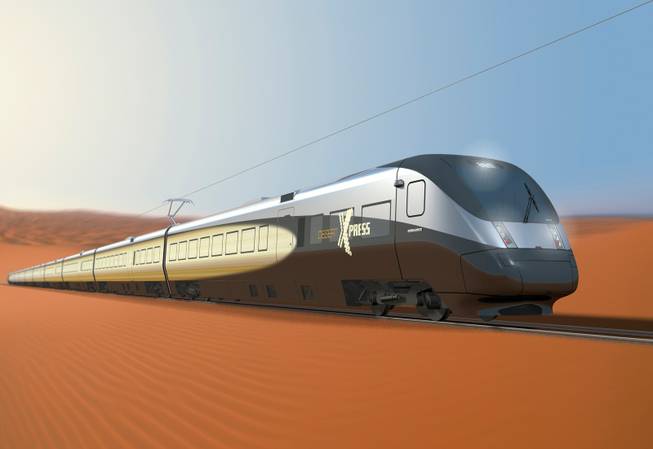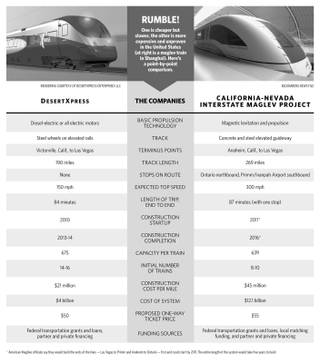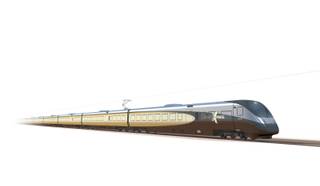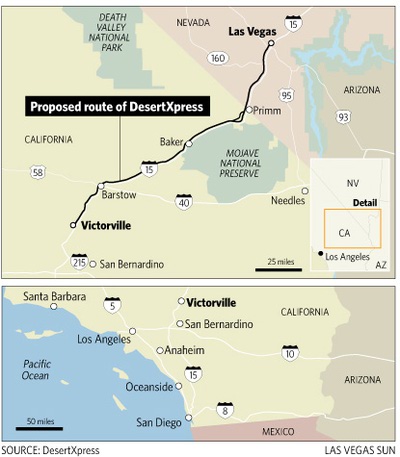
DesertXpress Enterprises, LLC.
The fully electric DesertXpress trains will reach top speeds of 150 miles-per-hour and travel 184 miles from Victorville, CA to Las Vegas, NV in 84 minutes.
Thursday, July 2, 2009 | 2 a.m.
Reader poll
Sun Archives
- High-speed train plan gets notice in D.C. (6-24-2009)
- Public or private, rail line will need major subsidies from government (6-14-2009)
- Maglev or DesertXPress, this could be your new ride (6-14-2009)
- Trade-offs between technologies include speed, cost (6-14-2009)
- Maglev train to press on without Reid (6-10-2009)
- Reid sides with Desert Xpress fast train option (6-9-2009)
- State sends no representative to talk on high-speed trains (6-5-2009)
- Obama outlines vision for high-speed rail network (4-16-2009)
- 8 states seek stimulus money for high-speed rail (4-15-2009)
- No waste in rail dream (3-5-2009)
- Economic crisis an opportunity to be greener (3-1-2009)
- Vegas, Midwest seek the $8 billion for fast trains (2-23-2009)
- Calif. bond would launch bullet train project (9-26-2008)
Sun Coverage
The U.S. Transportation secretary will announce today the designation of a federal high-speed-rail corridor between Las Vegas and Southern California, a major assist that enables the long-imagined train route to compete for $8 billion in economic recovery funding and other federal support, the Las Vegas Sun has learned.
The announcement comes as two proposed fast trains are vying to connect Las Vegas and Southern California, a race that has intensified since President Barack Obama unleashed an unprecedented investment in high-speed rail as part of the stimulus bill approved by Congress.
It is unclear whether today’s announcement will favor one of the competing projects over the other. However, the federal designation improves the chances that a train will be developed between the two regions by opening the door to federal aid. Analysts think only one train system will be built.
Secretary Ray LaHood is expected to join Senate Majority Leader Harry Reid and California Gov. Arnold Schwarzenegger’s transportation secretary for today’s announcement in Las Vegas.
Just last month, Reid announced he was giving up his longtime support of the California Super Speed Train Commission’s proposed $12 billion magnetic levitation train between Las Vegas and Anaheim, frustrated the public project had no tangible results in 30 years.
Instead, Reid is now backing the DesertXpress train to Victorville, a private project. Reid says the proposal, which emerged in 2002 with support from Republican political mogul Sig Rogich, has a better chance of getting built. Rogich is a longtime ally of Reid, and co-chairman of the senator’s 2010 reelection group Republicans for Reid.
As a private project, DesertXpress insists it has no interest in tapping the $8 billion in recovery money — although more recently its backers said they may seek federal loans to help finance the $5 billion project.
Yet train experts say there is one reason virtually no privately run passenger rail lines exist in this country, or the world: They don’t make financial sense. Most high-speed rail lines are subsidized with public money.
DesertXpress is eyeing an existing federal program that provides low-interest loans, payable in 35 years, for 100 percent financing.
A source familiar with today’s announcement said the corridor designation would potentially help either project.
“If it’s maglev, it makes it easier to compete for grant funding,” the source said. “If it’s DesertXpress, it does streamline the process for federally backed loans.”
Neither train proposal is perfect. The $12 billion maglev line to Anaheim relies on a technology untried in this country because experts say it is too expensive to build.
The $5 billion DesertXpress project ends in Victorville, a high-desert outpost 85 miles north of the Southern California basin — too far a drive, critics say, to woo passengers from cars or planes.
California has an interest in the Las Vegas lines, as both Nevada projects would connect eventually with California’s north-south trunk line — a $45 billion project linking San Francisco and Southern California. Maglev would connect at the California line’s planned station in Anaheim, and DesertXpress envisions a spur linking its Victorville stop to the California train’s Palmdale station, about 50 miles west.
Both Las Vegas trains would charge fares of about $50 each way.
Maglev’s supporters, including Bellagio executive Bruce Aguilera, met with LaHood in Washington this spring and pressed for the corridor designation.
The group asked for the project to be “designated as a high-speed rail corridor and considered for funding as part of the $8 billion,” according to letters from supporters at the time. The group also expects to court private dollars and loans.
“The corridor designation process certainly influences the possibility of getting funding in the future,” said Neil Cummings, president of American Magline Group, the consortium of engineering and construction firms developing the maglev line plan.
Corridor designation is a requirement in several aspects of recovery funding — to obtain grants for design and construction or matching funds to plan future spurs.
High-speed-rail corridors are considered long stretches, 100 to 600 miles between major cities, with a few sites in between.
Corridor designation may also be required for future rail development money in the upcoming multiyear transportation bill. Obama has requested an additional $5 billion in fiscal 2010 to continue his push for high-speed rail over the next five years.
Ten high-speed-rail corridors exist nationwide, chosen in the early 1990s as part of an initial effort to develop faster trains.
Under existing law, the transportation secretary has the authority to designate an 11th line.
But experts say those corridors were essentially chosen because they could be upgraded to make existing rail lines move faster, perhaps by eliminating grade crossings or softening curves.
The program languished without adequate funding during the Clinton and Bush administrations, critics say.
More recently, the Federal Railroad Administration suggested it would be revising the corridor list and updating it with perhaps new designations.
It is unclear whether the Las Vegas to Southern California corridor would become the 11th corridor or part of a new system.
Questions remain on the hurdles potentially blocking access to recovery dollars for maglev or DesertXpress — if the private company were to decide to seek federal money.
Recovery funding requires that the project be backed by a state, groups of states or regional authorities.
DesertXpress is a private enterprise currently unaffiliated with a state agency. Maglev’s commission is supported by Nevada, but not California.
Pre-applications for fast train projects seeking recovery money are due one week from Friday, with final applications due later this year.




Join the Discussion:
Check this out for a full explanation of our conversion to the LiveFyre commenting system and instructions on how to sign up for an account.
Full comments policy